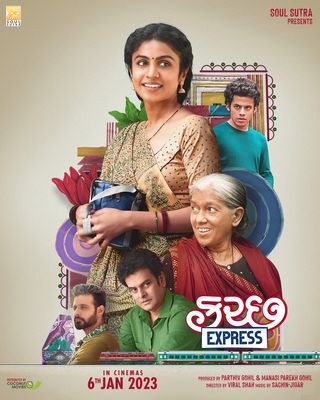If Abhishek Jain’s Bey Yaar (2014), about the relationship of two childhood friends, turned the ignition for Gujarati cinema, films like Chhello Divas (2015), Gujjubhai the Great (2015), Wrong Side Raju (2016) and Hellaro (2019) helped it gain momentum. And then came Pan Nalin’s Chhello Show in 2021, which was India’s official entry to the Oscars. It beautifully captured the wide-eyed wonder of a young cinema lover. And if anyone thought that was a lucky strike, Gujarati cinema did an encore with Viral Shah’s Kutch Express (2022), which won three national awards this year for best actress, best costume design and best feature film promoting national and social values.
Manasi Parekh, who won the best actress award, says she could not believe it at first. Initially, she had even doubted whether the film would be accepted as its narrative―about a female underdog’s entrepreneurial journey―was novel to a film industry not used to “bold and offbeat female-centric” stories. The film was produced by Parekh and her husband, and she says the limited budget for Gujarati films made it a challenging endeavour. “Despite all the limitations, the fact that we have won this award goes to show that newer, bolder and stronger narratives are now finding acceptance in Gujarati cinema,” Parekh tells THE WEEK. There was a suggestion that the film should be made in Hindi to reach a wider audience, but Parekh felt its authenticity would have been lost. A tale about a woman from Kutch should be set in Kutch, and it is this rootedness and realism that won the film accolades.
Still, Gujarati cinema has a long way to go, feels Jain, whose Bey Yaar is the first Gujarati film to have gotten a re-release 10 years after it came out. “Despite wins, if we think we have arrived then that thought process is problematic,” he says. “It would be right to say that the industry is evolving. There is now an increase in the audience size and base, but compared with other regional film industries, I feel we are behind.” He might have a point. For long, Gujarati cinema was inspired by Gujarati theatre, and the predominant genre it specialised in was situational comedy. The real game-changer, feels Pratik Gandhi, a well-known Bollywood actor from Gujarat, was Bey Yaar, which was massively popular “at a time when no one wanted to make or watch a Gujarati film”. “The kind of films that were made before Bey Yaar had a limited audience, and urban youngsters could not relate to them,” he says. His own career received a boost after the film. Until then, he had been busy juggling theatre and a full-time job in Mumbai. Still, he feels Gujarati cinema is at a phase where it is struggling to find its voice.

According to Gujarati screenwriter and lyricist Niren Bhatt, who is currently riding on the success of Stree 2, the audience is ready for more than comedy, but it is the filmmakers who lack the courage to experiment. Even films like Inception or Oppenheimer made in Gujarati would find takers. “If you stay true to your story, the audience is always ready,” he says. “Take the example of a film like Kantara. Nobody expected a Kannada film to [rake in] 0400 crore worldwide. If Kantara can do it, so can a Gujarati film.”
Bhatt is not writing Gujarati films anymore because his returns are less here. He gets paid 20 times more in Bollywood. “I put in equal effort for a Gujarati film like Bey Yaar or Wrong Side Raju as I did for Stree 2,” he says. “At the moment, the budget of a Gujarati film equals my remuneration in Hindi cinema, so they can’t afford me.” Recovering a film’s budget is a major problem in Gujarati cinema. Comparing Gujarati and Marathi cinema, Jain says that the Marathi film industry churns out at least five good films a year, while the Gujarati film industry has only produced five noteworthy films in the last 10 to 12 years.
There was a time, in the late 1990s, when the Gujarati family dominated Hindi soap operas and K-serials like Kyunki Saas Bhi Kabhi Bahu Thi on Star Plus. However, their popularity started waning in the early 2000s, when they were replaced by Marwari family dramas like Balika Vadhu. Then, Taarak Mehta Ka Ooltah Chashmah brought the Gujarati family dynamics back into the mainstream. “Somehow, I feel everyone is still trying to crack the code of Taarak Mehta in different settings like UP and Bihar,” says Bhatt. In music, too, remixes of Gujarati folk songs became hugely popular in Bollywood films, like the song ‘Chogada Tara’ from the Bollywood film LoveYatri (2018), which was a remix of a cult Gujarati number often played during Navratri; it has garnered over 800 million views on YouTube. Another example is the massively successful ‘Odhani’ from Rajkummar Rao’s film Made In China (2019), which was again the recreation of a Gujarati garba.
One reason for the low visibility and recall value of Gujarati films is the drain of talent to Bollywood. Many Gujarati actors like Ratna Pathak Shah, Paresh Rawal and Supriya Pathak have moved to Bollywood, even as they continue to work in Gujarati cinema. “Nobody will say no if the script is good, no matter the language. Our problem is that we have been stuck with the comedy genre for too long,” says Supriya, adding that a community that is culturally aware and appreciates good theatre will be able to embrace stories of all kinds. Another problem, according to her, is that many Gujarati films don’t get a proper release. She cites the example of Kesar, her first Gujarati film which was ahead of its time. The film got shelved, but a similar Bollywood film―Badhaai Ho (2018)―did well at the box office. She applauds Parekh for experimenting with different kinds of subjects.
Parekh herself is more optimistic about the prospects of the Gujarati film industry. “About 40 to 45 years ago, Paresh Rawal and his fraternity used to do Gujarati films, but after that there was a total slump and we had very shoddy productions,” she says. “And now, we have the young and wonder-eyed who are taking it upon themselves to bring about a resurrection. Today this language is becoming cool for young filmmakers and this national award is a strong validation of that.”



